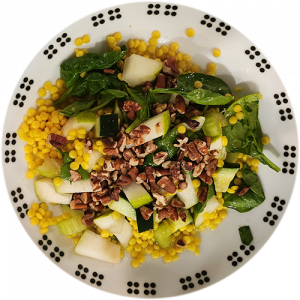The main course tonight is duck leg quarters with Asian apricot sauce. For a side, we had roasted Brussels sprouts and apple slices. The salad was diced pears, cucumber, and celery, tossed with cous cous in a lime honey dressing.
Duck and apricot sauce
 I tried cooking the duck leg quarters in a sous vide bath, finishing it in a hot skillet to get crispy skin. It worked surprisingly well. In the past, I’ve cooked the duck in a medium-low skillet, skin side down, for about twenty minutes to get that crispy skin, then flipped it for five more minutes at high heat. The problem with doing it this way is that you run the risk of the meat being overdone or underdone and/or burned skin. The sous vide method again appears to be fool-proof. I guessed at setting the bath at 150F for two hours, since that’s what works for chicken. It seemed okay here, too.
I tried cooking the duck leg quarters in a sous vide bath, finishing it in a hot skillet to get crispy skin. It worked surprisingly well. In the past, I’ve cooked the duck in a medium-low skillet, skin side down, for about twenty minutes to get that crispy skin, then flipped it for five more minutes at high heat. The problem with doing it this way is that you run the risk of the meat being overdone or underdone and/or burned skin. The sous vide method again appears to be fool-proof. I guessed at setting the bath at 150F for two hours, since that’s what works for chicken. It seemed okay here, too.
I used duck leg quarters tonight–legs with thighs still attached. Everything here would also work with duck breasts, except that the sous vide temperature should be lower–130F is the recommended temperature for sous vide duck breast. By the way, the usual temperature guidelines for meat temperatures don’t take into account the longer duration used in sous vide cooking; the extended time means that the lower temperatures will kill any residual bacteria on the meat.
Of course, the sous vide method won’t give you the Maillard reaction, so you need to sear the meat when it comes out of the cooker. It’s better if you don’t use a non-stick pan for searing. When the meat hits a hot stainless steel or wrought iron surface, it initially binds to the pan while the reaction forms. Once it’s properly seared, it releases, which is your signal to turn the meat. If you use a non-stick pan, you don’t get that “release” cue.
The apricot sauce was a variation of traditional Chinese duck sauce–that orange dipping sauce you see in Chinese restaurants. This didn’t turn out orange, but it was pretty tasty. This sauce would be good on chicken, too.
Cous Cous Salad
 We usually have a fruit salad for the evening meal, but I wanted to try something a little different. The cous cous added carbs and a texture to the salad, and the lime and honey dressing gave a nice, light flavor. The directions make this look hard, but it’s really easy–especially if you omit the toasted nuts.
We usually have a fruit salad for the evening meal, but I wanted to try something a little different. The cous cous added carbs and a texture to the salad, and the lime and honey dressing gave a nice, light flavor. The directions make this look hard, but it’s really easy–especially if you omit the toasted nuts.
Brussels Sprouts and Apples
This is pretty standard fair, and went nicely with the rest of the meal. The first two recipes are pretty long, so I’ll save posting details for later–although its hardly a mystery: slice Brussels sprouts, an apple, toss with olive oil, and roast in a 425F oven for twelve minutes.
Duck with apricot sauce
Equipment
- Sous Vide Cooker and bag for cooking
- Pan for searing duck NOT a non-stick pan.
- Small mixing bowl for sauce A prep bowl, a ramekin, or a coffee mug will do. It just needs to hold one cup of liquid with room to stir it.
Materials
For Sous Vide Duck
- 2 Duck leg quarters
- Herbs for sous vide bag
- Salt and Pepper to taste
For Sauce
- 1/2 C Apricot jam
- 1 TBSP Soy sauce
- 1 TSP Sweet Chili Sauce
- 2 TBSP Olive Oil
- 2 TBSP Honey
- 1 Clove Garlic Minced (optional)
Instructions
Sous vide step
- Bring sous vide bath to 150F. While the bath is heating, prepare the duck.
- Score the skin of the duck with a sharp knife. The cuts should be roughly half and inch apart, through the skin and into the subcutaneous fat but not into the underlying meat.
- Salt and pepper the duck. Be liberal with the salt, rubbing into the scores in the skin
- Place the duck in your plastic bag. Add any herbs you plan to use. I used thyme and rosemary since I have those growing in my kitchen.
- Seal the duck and herbs in the bag and place in Sous Vide bath for two hours.
Sauce
- Put the ingredients in a small mixing bowl.
- Mix the ingredients together. I have a mini-whisk I use, but a spoon should work.
Finishing the duck
- When the duck has cooked for two hours, it's ready to take out of the sous vide bath. It's perfectly ok to let it run longer, but you don't want to render all the fat out of the duck–you need some there to get that crisply skin. The duck will be medium rare. The temperature and duration of the bath will kill any bacteria.
- Remove the duck from the bags and discard any herbs still in the bag.
- Bring a saute pan to medium-high heat.
- While the pan is heating, dry the duck with paper towels. Wrap the duck in paper towels to soak up any water that's leaked into the bag during the sous vide bath. If it's not dry, you'll get lots of splatter when you put the duck in the saute pan–one of the things to be aware of when you finish sous vide meats on the stove.
- When the pan is hot–probably about five minutes–add 2TBSP of high-smoke oil like canola oil to the pan. ( To test if the pan is hot, add a drop of water in the pan. It will sizzle and disappear if it's hot.) Don't add the oil until the pan is hot. I don't recommend using olive oil, since it has a lower smoke point
- Put the legs in the pan, skin-side down, and let them cook. Expect some splatter, so if you have a splatter guard use it. Let them cook for at least a couple of minutes. If you try to turn them too soon, they will stick to the pan, so wait. They'll release when they ready to turn. That's one reason to not use a non-stick pan for this step.
- Increase the heat to medium-high and flip the duck. Cook for another minute or until the duck releases from the pan.
- Remove the duck from the pan and let rest for five minutes on a cutting board. This will keep oily fats leaking onto the plate and spoiling your presentation.
- To plate the duck, swirl some sauce onto the plate, put the duck on top of the swirl, then spoon more sauce over the duck.

Cous Cous Salad with Pears, Cucumber, and Celery
Ingredients
Dressing
- 4 TBSP Olive Oil
- 2 TBSP Lime juice plus zest of one lime
- 1 TBSP Sesame oil
- 2 TBSP Honey
- 1 garlic clove, minced (optional)
- Salt and pepper to taste
Salad
- 1/4 C loosely chopped nuts–I used pecans, but walnuts would work
- 1 Pear, cored, and cut in quarter inch dice
- 1 Small cucumber, cut into quarter inch dice
- 2 stalks celery, cut into quarter inch slices
- 1 C Pearl cous cous
- 1/2 C Spinach
- 1 C water
Instructions
Dressing
- Mince the garlic, if using. I used a garlic press, so I get the flesh of the garlic without the fibers. I
- Add all the ingredients to a prep bowl and mix. Adjust salt, pepper, and more honey to taste.
Salad
- Preheat oven to 350F
- Line small cookie sheet with parchment paper (NOT waxed paper, unless you want to practice with your fire extinguisher!)
- add lightly chopped nuts to cookie sheet.
- Place in oven for five to ten minutes, tossing once. Let cool on small plate.
- Bring one cup of water to boil
- Remove water from heat and add one cup of cous cous. Cover and let sit for five minutes. While it sits, continue with the recipe. You can do this step a day ahead.
- Core the pear and cut in quarter inch dice. One pear is enough for two big salads.
- Cut enough cucumber into quarter inch dice so that you have, by volume, the same as the pears.
- Cut the celery into quarter-inch slices, adjusting the number of stalks so you have about the same volume as the pears.
- Place the pear, cucumber, celery, and spinach in salad bowl.
- Fluff the cous cous–assuming five minutes have passed! If the cous cous is hot, rinse under cold water in a colander. Once cool, add it to the bowl with the other ingredients and toss.
- Add the dressing to taste. You should have enough dressing for four salads, so if you're cooking for two, you can save this in the refrigerator for at least a week.


Be First to Comment